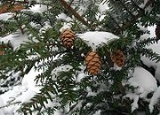
Tsuga diversifolia
Encyclopedia
Tsuga diversifolia, commonly known as the Northern Japanese Hemlock, or in Japanese, Kometsuga (米栂), is a species of conifer native to the Japan
ese islands of Honshū
, Kyūshū
, and Shikoku
. In Europe
and North America
, the species is sometimes employed as tree for the garden and has been in cultivation since 1861.
The bark
is an orange-brown in colour, shallowly fissured and vertically peeling. The bud
s are a deep purple red. The dull purple, ovoid pistillate flowers are terminal on either long or short shoots. They measure about 5 mm and as they mature become pale green with the centre and margin of each scale being purple. The cone
s are 1.8 to 2.8 cm long, cylindric-ovoid, and nearly sessile. They are dark brown, pendulous and the scales are slightly convex and ridged.
Japan
Japan is an island nation in East Asia. Located in the Pacific Ocean, it lies to the east of the Sea of Japan, China, North Korea, South Korea and Russia, stretching from the Sea of Okhotsk in the north to the East China Sea and Taiwan in the south...
ese islands of Honshū
Honshu
is the largest island of Japan. The nation's main island, it is south of Hokkaido across the Tsugaru Strait, north of Shikoku across the Inland Sea, and northeast of Kyushu across the Kanmon Strait...
, Kyūshū
Kyushu
is the third largest island of Japan and most southwesterly of its four main islands. Its alternate ancient names include , , and . The historical regional name is referred to Kyushu and its surrounding islands....
, and Shikoku
Shikoku
is the smallest and least populous of the four main islands of Japan, located south of Honshū and east of the island of Kyūshū. Its ancient names include Iyo-no-futana-shima , Iyo-shima , and Futana-shima...
. In Europe
Europe
Europe is, by convention, one of the world's seven continents. Comprising the westernmost peninsula of Eurasia, Europe is generally 'divided' from Asia to its east by the watershed divides of the Ural and Caucasus Mountains, the Ural River, the Caspian and Black Seas, and the waterways connecting...
and North America
North America
North America is a continent wholly within the Northern Hemisphere and almost wholly within the Western Hemisphere. It is also considered a northern subcontinent of the Americas...
, the species is sometimes employed as tree for the garden and has been in cultivation since 1861.
Description
T. diversifolia is an evergreen tree that attains heights of 25 m (80 feet). The crown is narrow, dense and conical. Young shoots are short, palely pubescent and bright orange to red-brown in colour. The densely arranged needles are linear-oblong and 5 to 15 mm long and up to 2.4 mm wide. They are a dark green in colour, glossy and furrowed above with two chalk white stomatal bands below.The bark
Bark
Bark is the outermost layers of stems and roots of woody plants. Plants with bark include trees, woody vines and shrubs. Bark refers to all the tissues outside of the vascular cambium and is a nontechnical term. It overlays the wood and consists of the inner bark and the outer bark. The inner...
is an orange-brown in colour, shallowly fissured and vertically peeling. The bud
Bud
In botany, a bud is an undeveloped or embryonic shoot and normally occurs in the axil of a leaf or at the tip of the stem. Once formed, a bud may remain for some time in a dormant condition, or it may form a shoot immediately. Buds may be specialized to develop flowers or short shoots, or may have...
s are a deep purple red. The dull purple, ovoid pistillate flowers are terminal on either long or short shoots. They measure about 5 mm and as they mature become pale green with the centre and margin of each scale being purple. The cone
Conifer cone
A cone is an organ on plants in the division Pinophyta that contains the reproductive structures. The familiar woody cone is the female cone, which produces seeds. The male cones, which produce pollen, are usually herbaceous and much less conspicuous even at full maturity...
s are 1.8 to 2.8 cm long, cylindric-ovoid, and nearly sessile. They are dark brown, pendulous and the scales are slightly convex and ridged.

